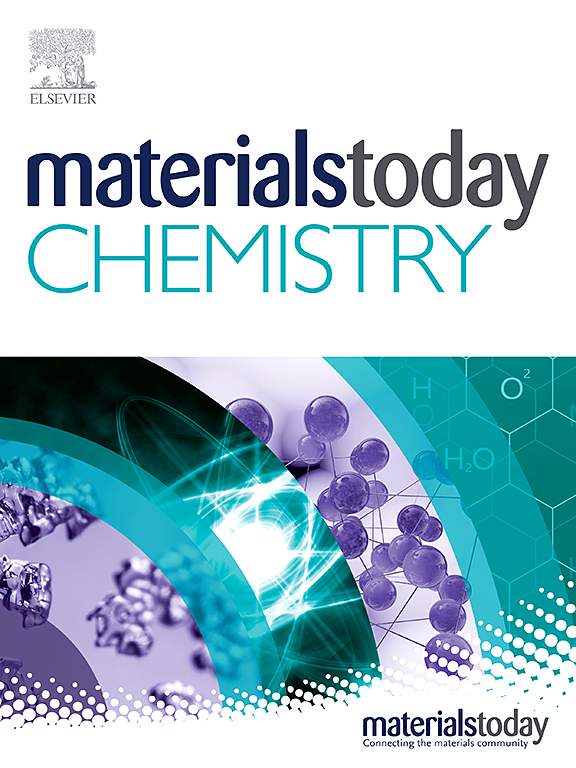Towards efficient blue aggregation-induced emission and delayed fluorescence molecules by locking the skeleton of indolocarbazole derivatives for non-doped OLEDs
IF 6.7
2区 化学
Q1 CHEMISTRY, MULTIDISCIPLINARY
引用次数: 0
Abstract
Although the design strategies for thermally activated delayed fluorescence (TADF) molecules have gradually become richer and more refined, challenges still exist in the design of such materials. Typically, the highly twisted donor (D)-acceptor (A)-type structure of TADF materials presents a challenging contradiction between the desire for a minimal singlet-triplet energy gap (Δ) and the pursuit of high oscillator strength/photoluminescence quantum yield (). This study proposes an effective TADF molecular design strategy, which involves selecting a highly rigidity and planarity indolocarbazole (ICz) donor and a molecularly locked acceptor to construct molecules with a D-A-D configuration, successfully creating successfully creating emitters with high and a small Δ. These molecules exhibit strong TADF and aggregation-induced emission (AIE) characteristics in nondoped films, with exceeding 70.0 % and small Δ, small nonradiative transition rate constant, and larger reverse intersystem crossing constant (). Acting as excellent emitters in OLEDs, they provide efficient electroluminescence with CIE=(0.148, 0.119) for 23bCzSOB and CIE=(0.219, 0.463) for 23bCzTPO, with the highest current efficiency (CE) and external quantum efficiency (EQE) reaching 29.5 cd/A and 14.9 % for 23bCzSOB and 36.9 cd/A and 21.6 % for 23bCzTPO, respectively. These results indicate that the molecular design of efficient delayed fluorescence molecules is successful and promising.通过锁定用于非掺杂有机发光二极管的吲哚咔唑衍生物骨架,实现高效的蓝色聚集诱导发射和延迟荧光分子
尽管热激活延迟荧光(TADF)分子的设计策略已逐渐变得更加丰富和完善,但此类材料的设计仍然存在挑战。通常情况下,TADF 材料的供体(D)-受体(A)型结构具有高度扭曲性,在追求最小单线-三线能隙(Δ)与追求高振荡强度/光量子产率()之间存在着极具挑战性的矛盾。本研究提出了一种有效的 TADF 分子设计策略,即选择一种高刚性和平面性的吲哚咔唑(ICz)供体和一种分子锁定的受体来构建具有 D-A-D 构型的分子,从而成功地创造出高Δ和小Δ的发射体。这些分子在非掺杂薄膜中表现出很强的 TADF 和聚集诱导发射(AIE)特性,其Δ超过 70.0%且小、非辐射转变速率常数小、反向系统间交叉常数大()。23bCzSOB 和 23bCzTPO 分别具有 CIE=(0.148, 0.119)和 CIE=(0.219, 0.463)的高效电致发光性能,是有机发光二极管中的优异发光体,其中 23bCzSOB 的最高电流效率(CE)和外部量子效率(EQE)分别达到 29.5 cd/A 和 14.9 %,23bCzTPO 的最高电流效率(CE)和外部量子效率(EQE)分别达到 36.9 cd/A 和 21.6 %。这些结果表明,高效延迟荧光分子的分子设计是成功和有前景的。
本文章由计算机程序翻译,如有差异,请以英文原文为准。
求助全文
约1分钟内获得全文
求助全文
来源期刊

Materials Today Chemistry
Multiple-
CiteScore
8.90
自引率
6.80%
发文量
596
审稿时长
33 days
期刊介绍:
Materials Today Chemistry is a multi-disciplinary journal dedicated to all facets of materials chemistry.
This field represents one of the fastest-growing areas of science, involving the application of chemistry-based techniques to the study of materials. It encompasses materials synthesis and behavior, as well as the intricate relationships between material structure and properties at the atomic and molecular scale. Materials Today Chemistry serves as a high-impact platform for discussing research that propels the field forward through groundbreaking discoveries and innovative techniques.
 求助内容:
求助内容: 应助结果提醒方式:
应助结果提醒方式:


